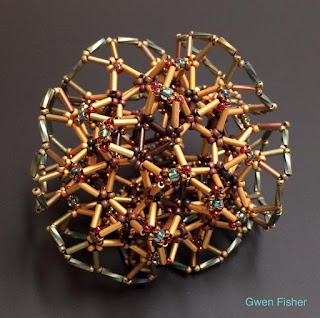Learn to make Floret Earrings and Necklace with this original variation
on Modified Prismatic Right Angle Weave (MPRAW). This version of MPRAW
is like Modified RAW described in Contemporary Geometric Beadwork, and
other beading patterns. This tutorial is written for intermediate
beaders who want to learn more about right angle weave (RAW). Knowledge of cubic RAW or
modified RAW is recommended.
This tutorial includes detailed instructions for making the Floret Earrings and the matching necklace with of tiny pendants with matching beaded beads. Everything uses Japanese seed beads in two different sizes with the addition of other small round, roundel and/or bicone beads. They are a wonderful way to small amounts of leftover seed beads and other small one-hole beads.
Each floret is 11/16 inch wide (12 mm) and almost an inch tall (23 mm). They’re small and light, making them comfortable to wear as earrings.
The tutorial is detailed including 15 colorful pages, with 110 full color illustrations and photographs. The tutorial gives detailed illustrations, photographs, and written instructions to make the Floret Earrings and matching necklace.
Thanks for looking!
This tutorial includes detailed instructions for making the Floret Earrings and the matching necklace with of tiny pendants with matching beaded beads. Everything uses Japanese seed beads in two different sizes with the addition of other small round, roundel and/or bicone beads. They are a wonderful way to small amounts of leftover seed beads and other small one-hole beads.
Each floret is 11/16 inch wide (12 mm) and almost an inch tall (23 mm). They’re small and light, making them comfortable to wear as earrings.
The tutorial is detailed including 15 colorful pages, with 110 full color illustrations and photographs. The tutorial gives detailed illustrations, photographs, and written instructions to make the Floret Earrings and matching necklace.
Thanks for looking!































